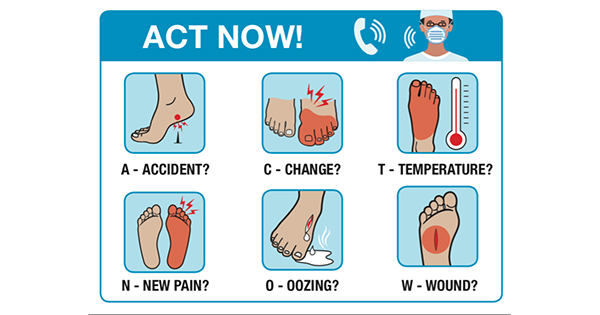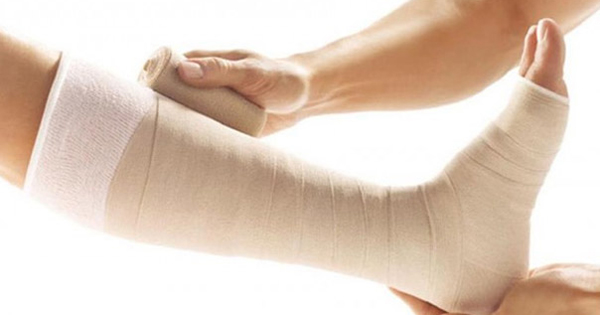Charcot neuroathropathy (CNA) is a complex and potentially destructive condition of the foot and ankle. CNA is most often seen in the Western world as a consequence of peripheral neuropathy secondary to diabetes mellitus. CNA is associated with fracture and dislocation of the bones and joints of the foot, leading to severe deformity, altered biomechanics and an increased risk of ulceration if left untreated (Johnson-Lynn et al, 2018).
Over the past 30 years, surgical treatment has become increasingly central to the management of CNA (Poulios et al, 2021). While the range of surgical procedures available for use in CNA is diverse, tendo-Achilles lengthening (TAL) appears to be one of the most widely used. TAL is frequently described as an adjunctive procedure as part of a more complex bone reconstruction (Stauff et al, 2011). However, TAL has also been proposed as an effective adjunctive measure in the primary management of acute CNA (Tiruveedhula et al, 2021).
Ankle equinus and Charcot neuroathropathy
Ankle equinus has been widely cited as a problematic pathomechanical feature of the diabetic foot. Ankle equinus has been reported as around twice as common in people with diabetes compared to non-diabetic groups (Frykberg et al, 2012). A combination of tendon glycosylation and motor neuropathy is thought to lead to alterations in the triceps surae’s mechanical properties (de Jonge et al, 2015). This manifests as an increased tension in the Achilles tendon, resulting in a reduction of ankle dorsiflexion, the production of a more powerful plantarflexion force during weight-bearing, and increased forefoot plantar pressures. Tension in the Achilles is also mechanically linked to increased loading of the midfoot structures. The simultaneous loading of the Achilles and forefoot places a flattening stress on the midfoot-arch complex. This flattening stress is resisted by several supportive midfoot structures, such as the plantar ligaments and fascia (Kirby, 2017). In the context of CNA, where ligamentous laxity and avulsion fractures are common, the supportive midfoot structures may be compromised. Accordingly, Achilles tension produces a deforming force in the midfoot, which may be implicated in the development of the CNA rocker-bottom foot (Colen et al, 2013). By targeting pathological tensioning of the Achilles early in the CNA disease process, some degree of the CNA’s severity may be averted (Figure 1).
The role of tendo-Achilles lengthening
The modified Eichenholtz classification (Shibata et al, 1990) proposes four stages of CNA development. The first stage (stage 0) presents a foot which appears clinically suggestive of acute CNA (swelling, erythema and warmth), yet appears radiographically normal. Typically, surgical intervention has been reserved for the later stages of CNA (stages 1–3) where deformity is radiologically overt. In light of the potential benefits of TAL, several authors have reported on the successful incorporation of TAL into acute CNA management (Holthusen and Kolodziej, 2009; Ramanujam and Zgonis, 2016; Laborde et al, 2016; Tiruveedhula et al, 2021). Most recently, Tiruveedhula et al (2021) proposed a four-stage treatment/classification system centred around the timely application of TAL in acute CNA. Their approach advocates the use of combined total contact casting (TCC) and TAL in CNA’s stage 0 phase. Such an approach may serve to ameliorate deforming forces before deformity becomes radiographically overt. A similar approach has been adopted within the Salford Care Organisation multidisciplinary foot care service (MDFS). With the inclusion of consultant foot and ankle orthopaedic surgeon, over the past 30 months, TAL has been performed on all acute CNA cases.
The use of tendo-Achilles lengthening in Charcot neuroathropathy: case report
This case report will describe the diagnosis, selection and operative techniques used in an acute late Stage 0 CNA. Also, the postoperative care and patient outcome measures in evaluating the success of the treatment.
A female patient, 62 years old, presented to the MDFS with warm swollen right foot, temperature difference of 4˚C, with known dislocation of second toe and osteomyelitis of third toe. The clinical presentation was concerning for Charcot. Figures 2 and 3 display the radiology dorsoplantar and lateral views weightbearing, respectively). She has type 2 diabetes, chronic kidney disease (stage 3), peripheral neuropathy, controlled hypertension, is under investigation for anaemia and has hereditary spherocytosis.
At the point of diagnosis, the patient was fitted with a total contact cast (toe–knee non-removable) and an orthopaedic plan for TAL procedure was consented. The patient was listed for surgery within 2 weeks of diagnosis.
On diagnosis, the X-ray report showed a widening of the Lisfranc and lack of congruency of the medial border of the base of the second toe metatarsal and medial border of the cuneiform, concerning for disruption of the Lisfranc ligament and concerning for Charcot arthropathy. Slight reduction in longitudinal arch was noted (Figure 2). This is considered late stage 0 Charcot neuroathropathy.
Selection
The orthopaedic review conducted a Silfverskiold test, which was negative (Silfverskiold, 1924). The orthopaedic assessment concluded an ankle equinus, with a soft tissue end feel on dorsiflexion and no bony deformity seen radiologically (stage 0 CNA). All assessments, therefore, indicated a soft-tissue reduction in dorsiflexion, which, as discussed above, is potentially impacting on the deformity associated with CNA. TAL is indicated as a suitable treatment plan to improve calcaneal pitch and prevent further mid-foot collapse, often seen in CNA (Tiruveedhula et al, 2021).
Procedure
The technique adopted in this case was a triple percutaneous hemisection of the Achilles tendon (Hoke technique) (Santamarina and Zislis, 2020). With the patient in the supine position and the extremity of the foot forced into dorsiflexion, the borders of the calcaneal tendon are identified by palpation. Three cuts are made through the skin: near Achilles tendon insertion; an intermediate cut approximately 2.5 cm above the distal cut; and the third cut a further 2.5 cm proximal to the middle cut. Each cut was greater than 50% across the tendon. The tendon hemisections are made percutaneously and then the foot is forced into dorsiflexion, which will cause the tendon to stretch, thus lengthening (Figures 4 and 5; Bowden and Forell, 2014).
Known risk factors associated with a TAL are Achilles rupture postoperatively and plantar calcaneal ulceration (Maluf et al, 2004).
Postoperative care
The patient was continually casted with a total contact cast until CNA was considered to be quiescent, both clinically and radiologically. This occurred within 8 weeks of surgery, 10 weeks from diagnosis (approximately 18 weeks in total, 8 weeks post-recalled trauma). The comparison between Figure 3 (at diagnosis) and Figure 6 (at quiescence) show an obvious change in the osseous alignment of the foot. Radiologically, this can be quantified using Meary’s angle and Calcaneal Pitch. Meary’s angle is obtained by measuring the angle of intersection between a bisecting line through the long axis of the talus and a bisecting line through the longitudinal axis of the first metatarsal. Calcaneal pitch is the angle created by a line drawn from the calcaneal tuberosity to the plantar aspect of the distal part of the calcaneus and a horizontal line drawn from the plantar calcaneal tuberosity to the fifth metatarsal head (Dasgupta et al, 2017). Figures 3 and 6 indicate an improvement of around 12° and 10° to Meary’s angle and Calcaneal pitch, respectively.
Discussion
Charcot care
Charcot is a complicated and difficult condition to prevent, diagnose, treat and manage long term. Early diagnosis is considered the key to achieving good outcomes. Differential diagnoses such as cellulitis, gout, deep vein thrombosis and venous oedema can lead to delays in care (Rosenbaum and DiPreta, 2015). The traditional treatment paradigm typically follows the Eichenholtz model of protected walking in a total contact cast or Charcot Resistant Orthotic Walker (CROW) until the foot appears settled clinically with a temperature difference of less than 2° and radiologically consolidated (Rosenbaum and DiPreta, 2015).
In this case study, incorporation of TAL into the management of stage 0 CNA led to a quantifiable improvement in osseous alignment. This was coupled with a 10-week casting duration, which appears to be in the lower end of reported stage 0 casting durations (range 8 to 34 weeks; Chantelau and Richter, 2013).
Metrics and outcomes for TAL
New interventions to improve CNA outcomes and reduce treatment time should be welcomed. Appropriate selection of outcome measures will help identify promising therapies. Quantifiable measures of osseous alignment, such as Meary’s angle and Calcaneal pitch, offer suitable metrics for short- and long-term follow up in CNA (Hastings et al, 2013; Kido et al, 2020). It is the authors’ anecdotal experience that improvements to Meary’s angle and Calcaneal pitch are a feature in most TAL-treated CNA patients. However, improvements in these angular measures were not as frequently observed in our non-TAL cohorts. Further research will be required to establish how TAL affects the long-term natural history of chronic CNA. It is unclear whether angular improvements are maintained, by how much TAL could reduce treatment time, or if TAL leads to reductions in acute relapse rates.
While TAL has been used in the management of CNA for some time, this is often in conjunction with reconstructive surgery. Midfoot collapse as a result of CNA can lead to complex surgery, which poses a significant risk of failure and further surgery, and/or amputation risk (Güven et al, 2013). Often with midfoot collapse, ulceration may follow as a result of the change in bony architecture and the development of the classic ‘rocker bottom’ deformity. This often carries the risk of osteomyelitis, which can delay reconstructive surgical intervention, and often ultimately results in below-knee amputation for patients (Güven et al, 2013). Optimised treatment of stage 0 CNA may be essential in minimising the likelihood of progression to midfoot deformity. Reduction of stress through the midfoot via TAL is a simple yet effective procedure, which could eventually feature in the clinical pathway for acute CNA. Further growth in the evidence base for TAL will help establish its place in the modern CNA treatment paradigm.
Due to the difficulties in accessing a professional with the appropriate skills to perform a TAL, the management of these patients is likely to fall on podiatry services. Within the Salford Care Organisation, an increased presence of orthopaedics in the MDFS has allowed patients timely access to surgical care. However, given national disparities in diabetic foot services, rapid access to orthopaedic and podiatric surgical consultations may not always be available (Paisey et al, 2018). Should TAL become more prevalent in the future, the national trend of up-skilling allied health professionals (AHPs) could serve to broaden access (Stressing and Borthwick, 2014). Specialist skills, such as minor surgery and independent prescribing, are now established elements of podiatric practice (Maher and Borthwick, 2021). Similarly, TAL could feasibly be added to the skillset of advanced practitioner podiatrists.
The principal of reducing Achilles tension to limit midfoot deforming forces could theoretically also be achieved conservatively. Approaches such as casting acute CNA cases in maximum ankle plantarflexion, in theory, may offload the midfoot. However, the practicalities of mobilisation and risk of further Achilles contracture would require special attention. Accordingly, new styles of casting may merit future research.
Conclusion
In patients with confirmed Charcot and soft-tissue ankle equinus, the early use of TAL may prove beneficial. Detecting and treating CNA early may allow relatively low-risk surgical intervention and a shorter recovery period. As well as early diagnosis of CNA, access to an MDFS is key to managing these patients (NICE, 2015). In Trusts without the support of an orthopaedic or podiatric surgeon through an MDFS, elective surgical interventions may well be difficult to access. In many Trusts across the UK, the wait for referral to orthopaedic services can delay care that would benefit patients at the point of diagnosis of CNA, arguably the point of greatest need. The pressure on surgical waiting lists has of course been exacerbated by the COVID-19 pandemic.
Demonstrating that early orthopaedic intervention in CNA is an effective treatment would be a paradigm shift that could improve the outcome and lives of these unfortunate individuals. Further research with patients randomised to either conventional treatment or conventional treatment with TAL would help to determine the efficacy of this treatment modality in early CNA. It would also help to build a case for inclusion of orthopaedic and/or podiatric surgical consultants, with a diabetic foot interest, to be actively involved in the MDFS. As a relatively minor procedure, it is a cost-effective intervention, when balanced against the ulceration rates, repeated and complicated surgical procedures and amputation costs that are often associated with poor management of CNA. If proven over time to be a reliable, reproducible and effective early intervention, TAL may reduce the ongoing costs and quality of life impact associated with CNA. While orthopaedic and podiatric surgeons are well placed to provide this type of procedure, adequately trained specialist podiatrists may also be suitable in the future.





